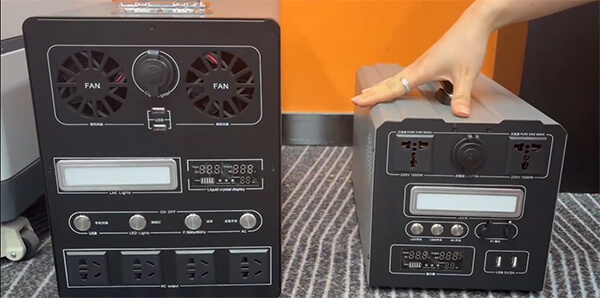Outdoor Power Supply: The Ultimate Portable Solution for Outdoor Energy Needs
Whether you're camping under the stars, broadcasting live in the great outdoors, or handling emergency rescues, outdoor power supply solutions have become essential for staying connected and powered up. With the increasing popularity of outdoor lifestyles, having access to reliable, portable electricity is no longer a luxury—it’s a necessity.
🔋 What Is an Outdoor Power Supply?
An outdoor power supply is a portable energy storage device that integrates a lithium-ion battery, an inverter, and multiple output ports. It converts stored DC power into AC electricity, making it suitable for running common electronics and appliances like:
- Laptops and smartphones
- Cameras and fill lights
- Electric cookers and kettles
- Projectors and camping fans
It’s often called a portable outdoor battery power station, and can be recharged via:
- Mains power (AC to DC charging)
- Solar panels (solar to DC charging)
- Car charging (DC input from vehicle battery)
This makes it a flexible, eco-friendly, and mobile solution for countless use cases.
⚙️ Key Components of Outdoor Power Supply Units
A high-quality outdoor power station generally includes:
Structural Protection
- Outer casing with shock-absorbing design
- Heat-resistant and waterproof materials
- Internal buffering for battery safety
Battery Pack Assembly
- Battery Management System (BMS) for safety
- Lithium-based battery packs (Li-ion or LiFePO4)
Input & Output Modules
- Inverter for AC output
- DC ports (USB-A, USB-C, car port, etc.)
- Display screens for monitoring status
These units are engineered to withstand rugged conditions while delivering stable, efficient, and safe power.

🧭 5 Key Applications of Outdoor Power Supply
1. ⛺ Outdoor Camping
The best outdoor power supply for camping provides electricity in remote areas where open flames are often restricted. Whether you need to:
- Brew tea with an electric kettle
- Cook meals with an induction cooker
- Watch a movie using a projector
An outdoor power station can handle it all—quietly and safely.
📌 Pro Tip: Choose a model with solar charging to ensure energy independence during longer stays.
2. 🆘 Emergency Power Backup at Home
Power outages due to storms, overloads, or grid maintenance are unpredictable. A portable outdoor battery power station can act as:
- A home emergency energy reserve
- Backup for medical devices
- Power source for routers, phones, and lighting
Having one on hand ensures you won’t be left in the dark—literally.
3. 🏗️ Outdoor Work & Construction
Professionals working on roads, pipelines, or geological surveys often operate in off-grid environments. Setting up temporary grid connections can be expensive and impractical.
A high-capacity portable power supply is:
- Cost-effective
- Easy to transport
- Capable of powering small tools, lights, and equipment
With optional solar panel charging, it can run indefinitely in daylight conditions.
4. 🎥 Outdoor Live Broadcasts & Photography
Creators, vloggers, and event planners depend on uninterrupted power. During outdoor shoots or live streams, power loss can ruin a production.
Use an outdoor power supply to run:
- DSLR and video cameras
- Fill lights and reflectors
- Laptops and monitors
The latest models offer PD fast charging, multiple outlets, and even quiet modes for noise-sensitive environments.
5. 🚑 Medical Emergencies & Rescue Operations
After natural disasters, electricity infrastructure may collapse. In such cases, a solar-powered outdoor generator can support:
- Communication tools
- Emergency lighting
- Medical equipment like portable ventilators or defibrillators
Some rescue-specific models come with LED flashlights, SOS beacons, and rapid-charging USB ports for emergency scenarios.
🔍 How to Choose the Best Outdoor Power Supply
Choosing the right unit depends on your specific needs. Here's a breakdown of factors to consider:
🧪 Battery Type: Prioritize Safety & Longevity
| Battery Type | Lifespan (Cycles) | Safety | Recommended For |
|---|---|---|---|
| Ternary Lithium | ~500 | Moderate | Occasional users |
| LiFePO4 (Lithium Iron Phosphate) | 2,000+ | High | Frequent outdoor users |
| Lithium Polymer | ~500–800 | Medium | Lightweight options |
📌 Tip: LiFePO4 is highly stable, resists overheating, and supports long-term use—ideal for camping, RVing, and emergencies.
⚡ Battery Energy (Wh): Know Your Output
- 300–500Wh: Short-term camping or powering phones/laptops
- 500–1000Wh: Weekend trips, cooking, lighting
- 1000Wh+: Construction, RV appliances, medical gear
Don’t just look at capacity (mAh)—pay attention to Wh (Watt-hours), which indicates real usable power.
🧳 Size & Portability
If you travel often or need to hike with the unit:
- Choose models under 10kg
- Look for foldable handles or wheel-mounted designs
- Check airline compliance for flight travel (if needed)
🔌 Port Variety: Compatibility Is Key
Look for units with a wide range of ports, such as:
- AC outlets (110V/220V)
- USB-A, USB-C (PD 100W)
- DC 12V car port
- Quick Charge 3.0 (QC3.0)
The more types you have, the more versatile the usage.
❓ People Also Ask
1. What’s the best outdoor power supply for camping?
Look for a model with 500–1000Wh capacity, solar charging compatibility, and multiple USB/AC ports. LiFePO4 batteries are recommended for safety and durability.
2. How long does an outdoor power supply last?
A high-quality unit with LiFePO4 batteries can last 6+ years with over 2,000 full charge cycles.
3. Can outdoor power stations be used indoors?
Yes! They're safe for indoor use, especially during power outages or as mobile office backups.
📘 Conclusion: Your Perfect Outdoor Power Supply Awaits
The best outdoor power supply isn’t about maximum specs—it’s about matching your needs:
- For camping? Go lightweight and solar-friendly
- For emergencies? Prioritize capacity and multiple ports
- For creators? Look for fast charging and AC stability
- For workers? Choose high output and durable design
🔋 Final tip: Always choose safety-first, preferably with LiFePO4 batteries, fast-charging options, and solar compatibility.
With the right unit, you’re free to explore, work, or live—without ever worrying about running out of power.Embrace new energy Net Zero by 2050.

